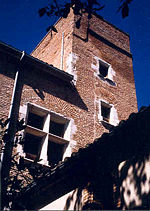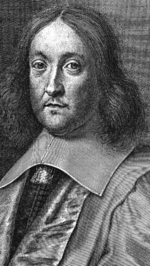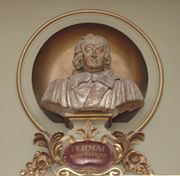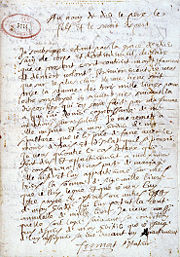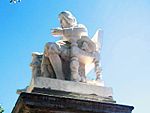Pierre de Fermat
2008/9 Schools Wikipedia Selection. Related subjects: Mathematics
| Pierre de Fermat | |
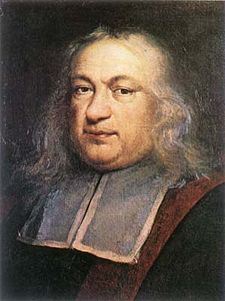 Pierre de Fermat
|
|
| Born | Beaumont-de-Lomagne, France |
|---|---|
| Died | 12 January 1665 (aged 63) Beaumont-de-Lomagne, France |
| Residence | France |
| Nationality | French |
| Fields | Mathematician and Law |
| Known for | Analytic geometry Probability Fermat's Last Theorem |
Pierre de Fermat IPA: [pjɛːʁ dəfɛʁ'ma] ( August 17, 1601 or 1607/8 – January 12, 1665) was a French lawyer at the Parlement of Toulouse, France, and a mathematician who is given credit for early developments that led to modern calculus. In particular, he is recognized for his discovery of an original method of finding the greatest and the smallest ordinates of curved lines, which is analogous to that of the then unknown differential calculus, as well as his research into the theory of numbers. He also made notable contributions to analytic geometry, probability, and optics.
Life and work
Fermat was born at Beaumont-de-Lomagne, 58 kilometers (36 miles) north-west of Toulouse, France. The late 15th century mansion where Fermat was born in Beaumont-de-Lomagne is now a museum.
In 1631, Fermat received the title of councilor at the High Court of Judicature in Toulouse, which he held for the rest of his life. Fluent in Latin, Greek, Italian, and Spanish, Fermat was praised for his written verse in several languages, and his advice was eagerly sought regarding the emendation of Greek texts.
Work
Fermat's pioneering work in analytic geometry, Ad Locos Planos et Solidos Isagoge, was circulated in manuscript form in 1636, predating the publication of Descartes' famous La géométrie. This manuscript was published posthumously in 1679.
In Methodus ad disquirendam maximam et minima and in De tangentibus linearum curvarum, Fermat developed a method for determining maxima, minima, and tangents to various curves that was equivalent to differentiation. In these works, Fermat also obtained a technique for finding the centers of gravity of various plane and solid figures, which led to his further work in quadrature.
Fermat was the first person known to have evaluated the integral of general power functions. Using an ingenious trick, he was able to reduce this evaluation to the sum of geometric series. The resulting formula was helpful to Newton, and then Leibniz, when they independently developed the fundamental theorem of calculus.
In number theory, Fermat studied Pell's equation, Fermat numbers, perfect, and amicable numbers. It was while researching perfect numbers that he discovered the little theorem. He also invented a factorization method which has been named for him as well as the proof technique of infinite descent, which he used to prove Fermat's Last Theorem for the case n = 4. Fermat also developed the two-square theorem, and the polygonal number theorem, which states that each number is a sum of three triangular numbers, four square numbers, five pentagonal numbers, and so on.
Although Fermat claimed to have proved all his arithmetic theorems, few records of his proofs have survived. Many mathematicians, including Gauss, doubted several of his claims, especially given the difficulty of some of the problems and the limited mathematical tools available to Fermat. His famous Last Theorem was first discovered by his son in the margin on his father's copy of an edition of Diophantus, and included the statement that the margin was too small to include the proof. He had not bothered to inform even Mersenne of it. It was not proved until 1994, using techniques unavailable to Fermat.
Although he carefully studied, and drew inspiration from Diophantus, Fermat began a different tradition. Diophantus was content to find a single solution to his equations, even if it were an undesired fractional one. Fermat was interested only in integer solutions to his Diophantine equations, and he looked for all possible general solutions. He also often proved that certain equations had no solution, which usually baffled his contemporaries.
Through his correspondence with Blaise Pascal in 1654, Fermat and Pascal helped lay the fundamental groundwork for the theory of probability. From this brief but productive collaboration on the problem of points, they are now regarded as joint founders of probability theory.
Fermat's principle of least time (which he used to derive Snell's law in 1657) was the first variational principle enunciated in physics since Hero of Alexandria described a principle of least distance in the first century CE. In this way, Fermat is recognized as a key figure in the historical development of the fundamental principle of least action in physics. The term Fermat functional was named in recognition of this role.
Death
He died at Castres, age 57 or 63, 79 kilometers (49 miles) east of Toulouse. The oldest, and most prestigious, college in Toulouse is named after him - the Pierre de Fermat.
Assessment of his work
Together with René Descartes, Fermat was one of the two leading mathematicians of the first half of the 17th century. Independently of Descartes, he discovered the fundamental principles of analytic geometry. With Blaise Pascal, he was a founder of the theory of probability.
Regarding Fermat's work in analysis, Isaac Newton wrote that his own early ideas about calculus came directly from "Fermat's way of drawing tangents."
Of Fermat's number theoretic work, the great 20th century mathematician André Weil wrote that "... what we possess of his methods for dealing with curves of genus 1 is remarkably coherent; it is still the foundation for the modern theory of such curves. It naturally falls into two parts; the first one ... may conveniently be termed a method of ascent, in contrast with the descent which is rightly regarded as Fermat's own." Regarding Fermat's use of ascent, Weil continued "The novelty consisted in the vastly extended use which Fermat made of it, giving him at least a partial equivalent of what we would obtain by the systematic use of the group theoretical properties of the rational points on a standard cubic." With his gift for number relations and his ability to find proofs for many of his theorems, Fermat essentially created the modern theory of numbers.
